
outlook自定义快捷键
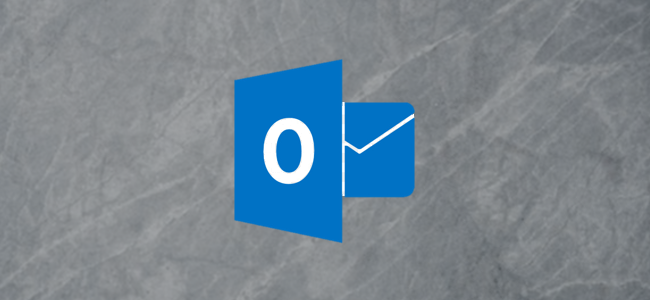
Back in Outlook 2010, Microsoft introduced the Conversation View, which works something like Gmail’s conversation threading. It’s turned on by default in newer versions Outlook, but not if you upgraded from an older version where it was switched off. So, if you didn’t know it was there, it might be time to take a look.
早在Outlook 2010中,Microsoft引入了Conversation View ,它的工作原理类似于Gmail的会话线程。 默认情况下,它在新版本的Outlook中处于启用状态,但如果是从已关闭的旧版本进行升级,则不会启用。 因此,如果您不知道它在那里,可能是时候看看。
什么是对话视图? (What is the Conversation View?)
Although Microsoft talked up the Conversation View a lot when they introduced it, most people outside of corporate IT departments and readers of high-quality tech websites probably weren’t aware of it. After all, when was the last time you looked for and read through the “new features” article on an app you use?
尽管Microsoft在介绍“对话视图”时大声疾呼,但公司IT部门以外的大多数人和高质量技术网站的读者可能都不知道它。 毕竟,您上次寻找和阅读所用应用程序上的“新功能”文章是什么时候?
This is a pity because Conversation View is a handy feature that a lot of people wanted after seeing conversation threading in Google’s new Gmail, which debuted in 2004/5. Such was the demand that suddenly everyone was talking about how to use the “Conversation” column to group emails in Outlook 2003, although this only picked up mails in the same folder. So some convoluted workarounds were fashioned using dynamic search folders, but this was all a bit crude compared to the AJAX-powered ease of Gmail.
遗憾的是,“对话视图”是一个方便的功能,很多人在看到Google的新Gmail中的对话线程后便希望使用该功能,该新Gmail 于2004/5年首次亮相 。 这样的需求使得突然之间, 每个人都在谈论如何使用“对话”列在Outlook 2003中对电子邮件进行分组,尽管这只能在同一文件夹中拾取邮件。 因此,使用动态搜索文件夹构建了一些复杂的解决方法 ,但是与AJAX支持的Gmail易用性相比,这一切都有些粗糙。
Microsoft got on the case and added a proper Conversation View—one that pulls emails from all folders—when they rolled out Outlook 2010. This might seem a bit late, seeing as their previous version came out 3 years earlier (Outlook 2007), but one can only assume that it took the product managers at Microsoft a while to realize just how popular Gmail’s threaded conversation view was, by which point it was too late to add it to 2007. No matter, Outlook 2010 got it, and it was a decent effort that has worked well in all iterations since.
当他们推出Outlook 2010时,Microsoft接受了此案,并添加了适当的“对话视图”(可从所有文件夹中提取电子邮件)。这似乎有点晚了,因为它们的早期版本早于3年前(Outlook 2007)。只能假设Microsoft的产品经理花了一段时间才意识到Gmail的线程对话视图的流行程度,到那时将其添加到2007年为时已晚。无论如何,Outlook 2010都可以使用它,从那以后在所有迭代中都表现良好的体面努力。
Since Outlook 2013 it’s been switched on by default, but in many businesses, it’s still turned off by default by the IT department. Also, if you turned it off in your old version of Outlook, it stays off when you upgrade to a new version. One of our geeks turned it off five years ago in Outlook 2013, and it’s still off now that they’re on Outlook 2019. It’s turned on by default in the Outlook web app as well, so it’s more well-used there, but for plenty of people, the Outlook client is their main email app.
自Outlook 2013起,默认情况下已将其打开,但在许多企业中,IT部门仍默认将其关闭。 另外,如果您在旧版本的Outlook中将其关闭,则在升级到新版本时,它将保持关闭状态。 我们的一位极客在5年前在Outlook 2013中将其关闭,但在Outlook 2019中仍处于关闭状态。默认情况下,Outlook Web应用程序中也将其关闭,因此在该处使用更为广泛,但对于人们很多,Outlook客户端是他们的主要电子邮件应用程序。
Let’s take a look at how to turn Conversation View back on and what customization options you have. Better late than never!
让我们看一下如何重新打开“对话视图”以及您拥有哪些自定义选项。 迟到总比不到好!
如何打开和关闭对话视图 (How to Toggle the Conversation View On and Off)
You can turn the Conversation View on and off via a simple toggle, so if you try it and don’t like it, it’s easy to turn it back off. To turn it on, switch on the View > Show as Conversations option.
您可以通过一个简单的开关来打开和关闭“对话视图”,因此,如果您不喜欢它,可以很容易地将其关闭。 要打开它,请打开“视图”>“显示为对话”选项。

Outlook displays a confirmation message that gives you the option to turn on the view in every folder (“All Mailboxes”) or just the current folder (“This Folder”).
Outlook显示确认消息,使您可以选择打开每个文件夹(“所有邮箱”)或仅当前文件夹(“此文件夹”)中的视图。

Try switching on “This Folder,” which will give you a chance to see if you like it before turning it on everywhere. To turn Conversation View off entirely, switch the View > Show as Conversations option off again.
尝试打开“此文件夹”,这将使您有机会先查看自己是否喜欢它,然后再将其打开。 要完全关闭“对话视图”,请再次关闭“视图”>“显示为对话”选项。
会话视图有什么作用? (What Does Conversation View Do?)
Conversation View arranges your messages into a thread in chronological order, with the newest message on top. These are initially hidden under the top message, with a triangle to the left side to denote that there is a thread below.
会话视图将您的消息按时间顺序排列到一个线程中,最新消息位于最前面。 这些最初隐藏在顶部消息的下方,左侧带有三角形,表示下面有一个线程。

Clicking on the triangle expands the thread and show the emails.
单击三角形可展开线程并显示电子邮件。

The very top message is the conversation header, and it isn’t a message. Instead, it contains the name of the person who started the conversation and the subject. If you click on it, you won’t see anything in the Reading Pane.
最上面的消息是对话标题,它不是消息。 相反,它包含发起对话的人的名称和主题。 如果单击它,则在“ 阅读窗格”中将看不到任何内容。
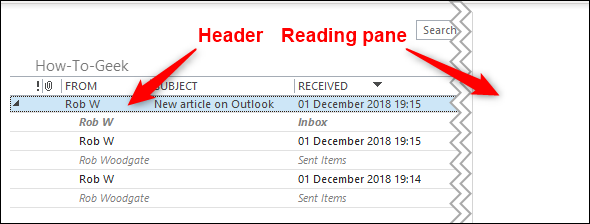
If you click on any of the messages under the header, Outlook displays them in the Reading Pane as normal. New messages are automatically added to the top of the conversation under the header, and shown in bold italics to indicate they haven’t been read yet.
如果您单击标题下的任何消息,Outlook会正常在阅读窗格中显示它们。 新邮件会自动添加到标题顶部的对话顶部,并以粗体斜体显示,表示尚未阅读。
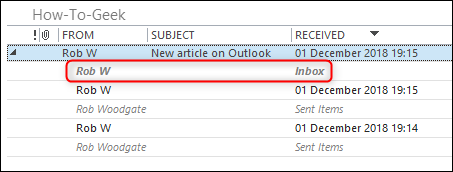
A conversation with a new message is automatically sent to the top of the folder, so the most recent conversations are always at the top.
带有新消息的对话会自动发送到文件夹的顶部,因此最新对话始终位于顶部。
This also demonstrates one of the strongest features of the Conversation View, namely that it picks up email from anywhere in Outlook and shows it in a single place, with the name of the folder that contains the mail prominently displayed. In this conversation, there are mails in the current folder, the Inbox and also the Sent Items folder. If we were to apply the Conversation View to the Inbox, we’d see the exact same conversation.
这也演示了“对话视图”的最强功能之一,即它可以从Outlook中的任意位置提取电子邮件并将其显示在一个位置,并突出显示包含该邮件的文件夹的名称。 在此对话中,当前文件夹,“收件箱”和“已发送邮件”文件夹中都有邮件。 如果我们将“对话”视图应用于收件箱,我们将看到完全相同的对话。
您如何自定义对话视图 (How Do You Customize the Conversation View)
Under the View > Show as Conversations option, there is the Conversation Settings option. Click on this to show the conversation options.
在“视图”>“显示为对话”选项下,有“对话设置”选项。 单击此按钮显示对话选项。
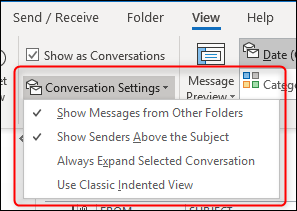
The options are:
选项包括:
Show Messages from Other Folders: Displays messages in the conversation no matter which folder they’re in. If this is switched off, you’ll only see the conversation messages that are in the folder you currently viewing.
显示来自其他文件夹的消息:无论会话位于哪个文件夹中,都将在会话中显示消息。如果将其关闭,则只会看到当前查看的文件夹中的会话消息。
Show Senders Above the Subject: Displays the sender name at the top of the conversation, rather than the subject, when in compact mode (the default view for folders in Outlook). The screenshots below show when the setting is on and off, respectively.
在主题上方显示发件人:在紧凑模式(Outlook中文件夹的默认视图 ) 下 ,在会话顶部而不是主题中显示发件人名称。 下面的屏幕截图分别显示了该设置的打开和关闭时间。
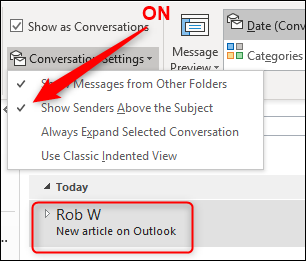
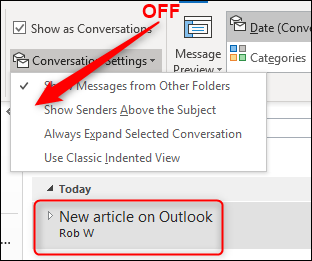
Always Expand Selected Conversation: Displays the currently selected conversation in expanded mode all the time, even if you leave the folder and come back to it. If you want a specific conversation to always appear in expanded mode in every folder that contains one of the mails in the conversation, you’ll have to enable this option in every one of the folders.
始终展开选定的对话:即使您离开该文件夹并返回到该文件夹,也始终以展开模式显示当前选定的对话。 如果希望特定对话始终以展开模式显示在包含对话中邮件之一的每个文件夹中,则必须在每个文件夹中启用此选项。
Use Classic Indented View: Displays the messages in a sloping indent, with the older the message the greater the indent. This is a folder setting that will apply to every conversation in the folder.
使用经典缩进视图:以倾斜的缩进显示消息,消息越旧,缩进越大。 这是一个文件夹设置,将应用于该文件夹中的每个会话。
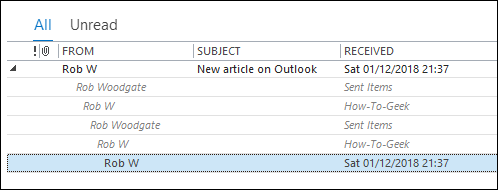
There is one more customisation setting, which you can find in Files > Options. Choose the “Mail” category on the left and then scroll down to the “Other” section to find the “Don’t automatically expand conversations when using the keyboard to change messages” setting.
还有另一种自定义设置,可以在“文件”>“选项”中找到。 选择左侧的“邮件”类别,然后向下滚动至“其他”部分以找到“使用键盘更改邮件时不自动展开对话”设置。

By default, this setting is switched off, so when you use the Up and Down arrows on your keyboard to navigate through a folder, conversations are automatically expanded when you select them. If you turn this setting on, conversations will stay contracted when selected using the keyboard, and you can use the LEFT and RIGHT arrow keys to manually expand and contract them. This is particularly useful if you’re the sort of person who prefers to use the keyboard whenever possible.
默认情况下,此设置处于关闭状态,因此当您使用键盘上的向上和向下箭头浏览文件夹时,选择对话会自动展开对话。 如果打开此设置,则使用键盘选择对话时,对话将保持收缩状态,并且可以使用向左和向右箭头键手动展开和收缩对话。 如果您喜欢在可能的情况下使用键盘,那这将特别有用。
That’s the Conversation View, Microsoft’s attempt at threading conversations. We think it’s pretty good, with enough customisations to appeal to different users, but not so much that’s it’s hard to use. And if it doesn’t suit you, you can turn it back off by switching the View > Show as Conversations option off again.
这就是“对话视图”,即Microsoft尝试对对话进行线程化的尝试。 我们认为它非常好,具有足够的自定义项以吸引不同的用户,但并不是很多,因此很难使用。 如果不适合您,可以通过再次关闭“视图”>“显示为对话”选项将其关闭。
翻译自: https://www.howtogeek.com/397298/how-to-toggle-and-customise-conversation-view-in-outlook/
outlook自定义快捷键




















 2893
2893











 被折叠的 条评论
为什么被折叠?
被折叠的 条评论
为什么被折叠?








